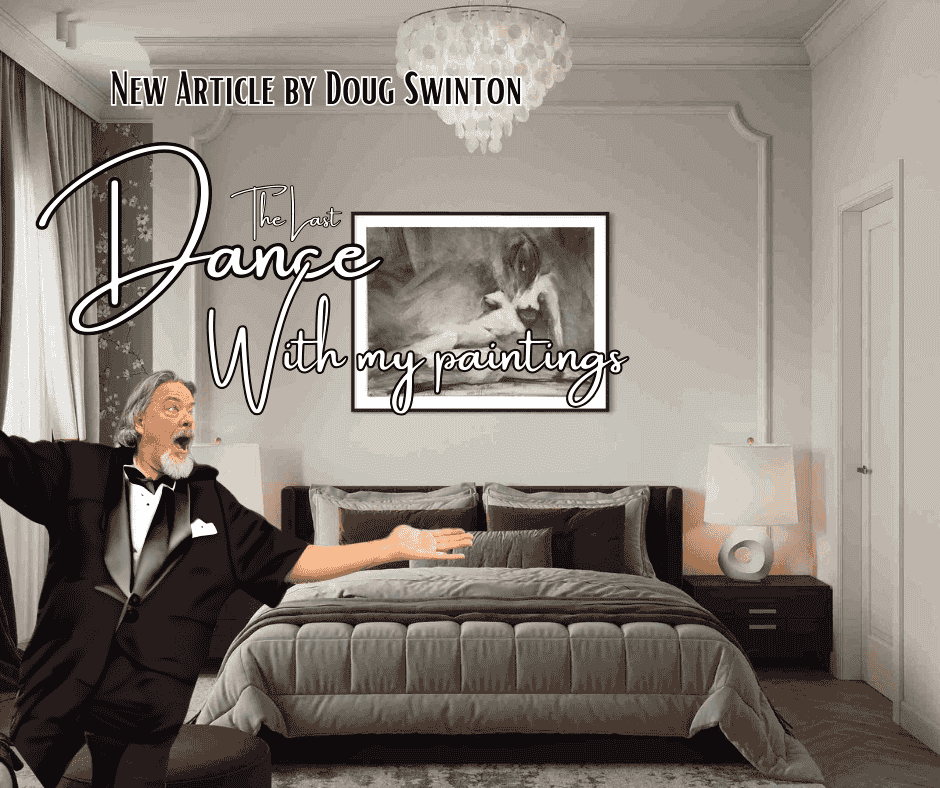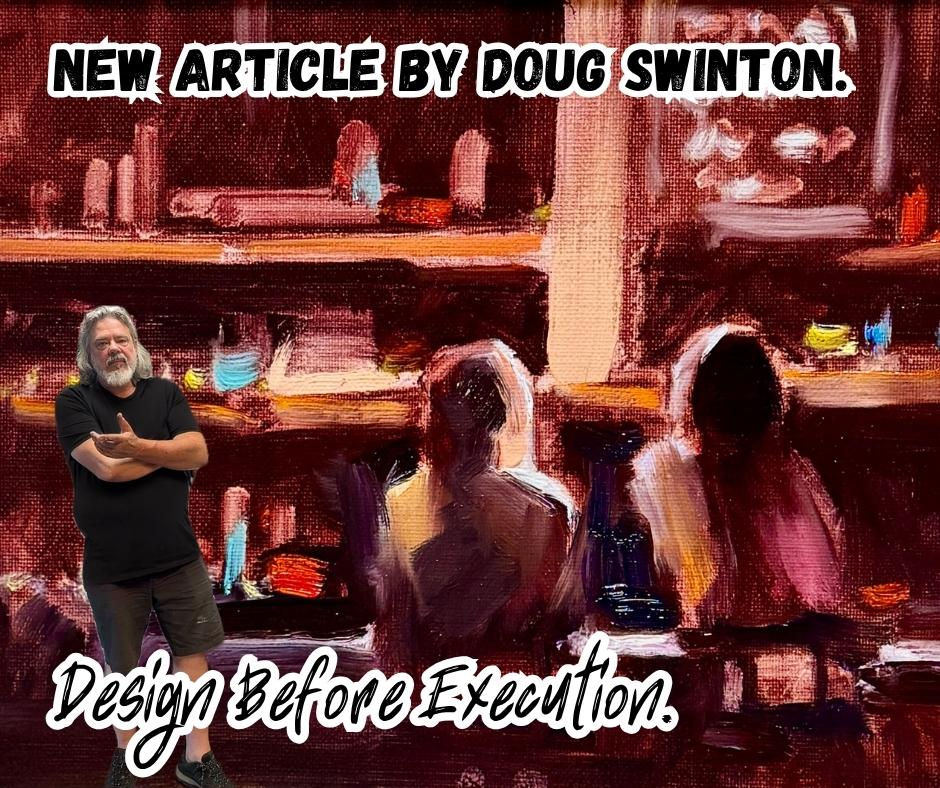9 Ways Photos Lie to a Painter
- Doug Swinton

- Jan 10, 2020
- 6 min read
Updated: Mar 15, 2021
The devil is in the details.

I must preface this article by stating that if you have a good camera and know how to work the settings, you can overcome most of the problems listed below. This advice is for those of you that are like me and stick to the on and off button.
From the first moment photographs were invented, artists have used them as a means to an end. Although they are not a substitute for the natural world, the reality is that photo reference for painters is very common.
Obviously, not all photos are bad and some can be amazing. The crux of the matter is that no matter how wonderful a photo is, for its sheer beauty or the memory factor, all photos tell lies. But don’t worry, you can overcome some of these issues by knowing how the photo is lying to you.
1. Focus People! Focus!
The problem with most cameras (especially the one in your iPhone) is that they take pictures with everything in focus. This is not natural. We don’t see this way. When you focus on something, everything around it blurs out.
Your camera (when not set correctly) will render everything in detail. Too much detail can be the death of any painting because the more detail that’s presented, the more detail the brain wants. Detail fuels a desire that’s technically impossible to satisfy.
This is especially true when painting backgrounds. If you over-modelled your background, the need for even more details in the mid and fore ground becomes overwhelming.
You don’t have to paint every twig or gopher that you see in the photo. Leaving something for the imagination is always a better choice. The brain will make
up what it needs better than anything you could ever paint.
Solution: Use texture rather than detail.
2. Horizontal perspective Skew
Cameras are notorious for throwing the horizontal perspectives off. This gets worse when using a telephoto or zoom lens. The more you zoom in the more your perspective will be out. This happens all too often when people zoom in to take a portrait.
When you use a telephoto lens or zoom in to get close, the far side of the face starts to flip around and flatten your photo out giving a 2-dimensional feel. The more you zoom in the more your horizontal line will skew away from horizontal.
This is called pin cushion distortion, most noticeable in images with straight lines. The further the lines are away from the centre of the image, the more noticeable the distortion will be. In portraits this can cause heads to look too small when compared to hands and shoulders.
With a wide angle lens, the closer you are to your subject the more barrel
distortion you will get. Using a wide angle lens for a portrait will cause the nose to look big and bulbous. The best focal length for portraits is
50mm and above when trying to avoid distortion.

3. Verticals Perspective Skew
For the most part, your painting will use one or two-point perspective. Unless you are painting Spiderman zipping from tall buildings, there is no need for three-point perspective and therefore we can assume that all vertical lines contain no perspective to speak of and can remain vertical.
The result of using a wide-angle or a zoom lens is that vertical lines that should be parallel begin to converge, portraying an unwanted perspective.
For example: buildings appear to fall backwards more severely when the camera is pointed upward from ground level than they would if photographed with a normal lens.
When you have tall items to photograph, back off the zoom. You’re better to shoot from a distance and later use your computer to do the “zooming” by cropping the image.

4. Lens Pile Up
Although it is highly recommend to buy a good camera if you are serious about painting from photographs, you need to know that they too have their little white lies just as your smart phone or tablet. Whatever device you are using, nasty things can happen when zooming in.
What is commonly know as lens distortion comes in two forms; extension distortion and compression distortion.
Extension distortion happens when you are using a wide-angle lens (for taking panoramic scenes). Objects close to the lens appear abnormally large relative to more distant objects, and distant objects appear abnormally small and hence farther away – distances are extended the wider you go.
Although you can see everything, hills shrink and mid grounds get pushed back, leaving the photo looking weak and minuscule. The phrase “objects in the mirror are closer than they appear” comes to mind.
Compression distortion happens when you are using a telephoto (zoom) lens (with an angle of view narrower than a normal lens). With this lens, objects from foreground to background look approximately the same size – closer objects are abnormally small, and more distant objects are abnormally large, hence the viewer cannot discern relative distances between distant objects – in short, distances are compressed.
Cell phones don’t have these lens issues but they have different problems, namely that the edges of photos get distorted.
This ball should be spherical not elliptical.

This can cause grief especially in still life photos. If you don’t like this effect, you need to with take a picture of your subject from a distance and crop it later.
5. Average Colour
Dslr cameras have a much wider dynamic range (the range of luminance values between the darkest and brightest perceptible points in an image), so they are much better for capturing colour than smartphones but they skew colours as well. For the most part, all cameras tend to average out colours. There may be three or four colours in a shadow you’re perceiving but the photo shows just one generalized colour.
This issue gets worse when you print your pictures in a place like Costco. Their machine takes the camera's average and average it out further.
6. Stuck In The Middle With You
Cameras have come a long way from the days of the focus being in the middle of the view finder. Many a bad photo was shot because of this silly focus donut thingy that was placed smack dab in the middle of the viewfinder, screaming at you to put everything in the centre of your shot. How could you resist?


7. Blow Out
When exposing for the light areas, chances are the darks will be too dark. If you focus on the darks then the lights will be blown out (too light) with no information or temperature in them.
Remember: when working from your reference photo, paint your shadows areas a bit lighter in value and you will gain more luminosity in your painting. Leave some room for dark accents.
To fix blown out highlights, make sure you add a temperature to your lightest lights. It can be cool or warm, but to make your painting stand out it needs a clear temperature because pure white lacks vitality.
Alternately, open your photo in any one of the photo editing apps and lighten the shadows. If you're cheap like me, you can hold your printed photo up to a well-lit window, or backlight it with the flashlight on your cell phone to see what is hidden in those dark areas. Try it.
8. Duplicity
One of the perils of photo reference is when a painter uses multiple photos to paint their composition. There is nothing wrong with this if the multiple photos were shot at the same location, same light source and time in sequence. Just make sure you don’t start to mix and match photos like the bulk bins at the grocery store! Be very aware to use the same direction of light, etc.
The time of year needs to be considered as well. At our latitude, the position of the sun varies immensely from summer to winter. Nothing is weirder than seeing a painting with shadows going all over the place.
The other thing I see all too often are buildings that are out of perspective. If the artist uses different photos taken from different distances and angles, they sit on different horizon lines and have different vanishing points.
9. Edit Edit Edit
For some reason, when we use photos as reference we have a strong compulsion to paint every little thing we see. EDIT… Take out the stuff that is not important. If you can’t see it when you squint, leave it out of your painting. Unless you are renting a hall and a caterer you’re not married to the photo. Take some liberties and use the photo as a starting point. Leave out all that detail. A painting should be a poem, not a police report.
Happy editing,
Your friend in art
Doug.








No boring Football Bros IO playbooks or serious commentary here—just pure fun and absolute chaos!
sex and wellness are deeply connected, influencing both mental and physical health. Practices like mindful intimacy, self-exploration, and partner communication enhance satisfaction and emotional well-being. Exercise, diet, and stress management also play a role. Embracing sexual health as part of overall wellness fosters confidence, balance, and a fulfilling lifestyle.
Ready for some fast-paced fun? Doodle Baseball is the ultimate time-killer! Tap to swing and time your hits to perfection in this charming, challenging Doodle Baseball game.
Unlike many modern games, Crazy Cattle 3D ditches unlocks and upgrades, focusing entirely on player skill. Success comes from mastering movement, timing, and positioning, not grinding for better gear.
Embark on a never-ending adventure with Templer Run! Can you run through countless obstacles and collect coins along the way? Challenge yourself and see how far you can last!